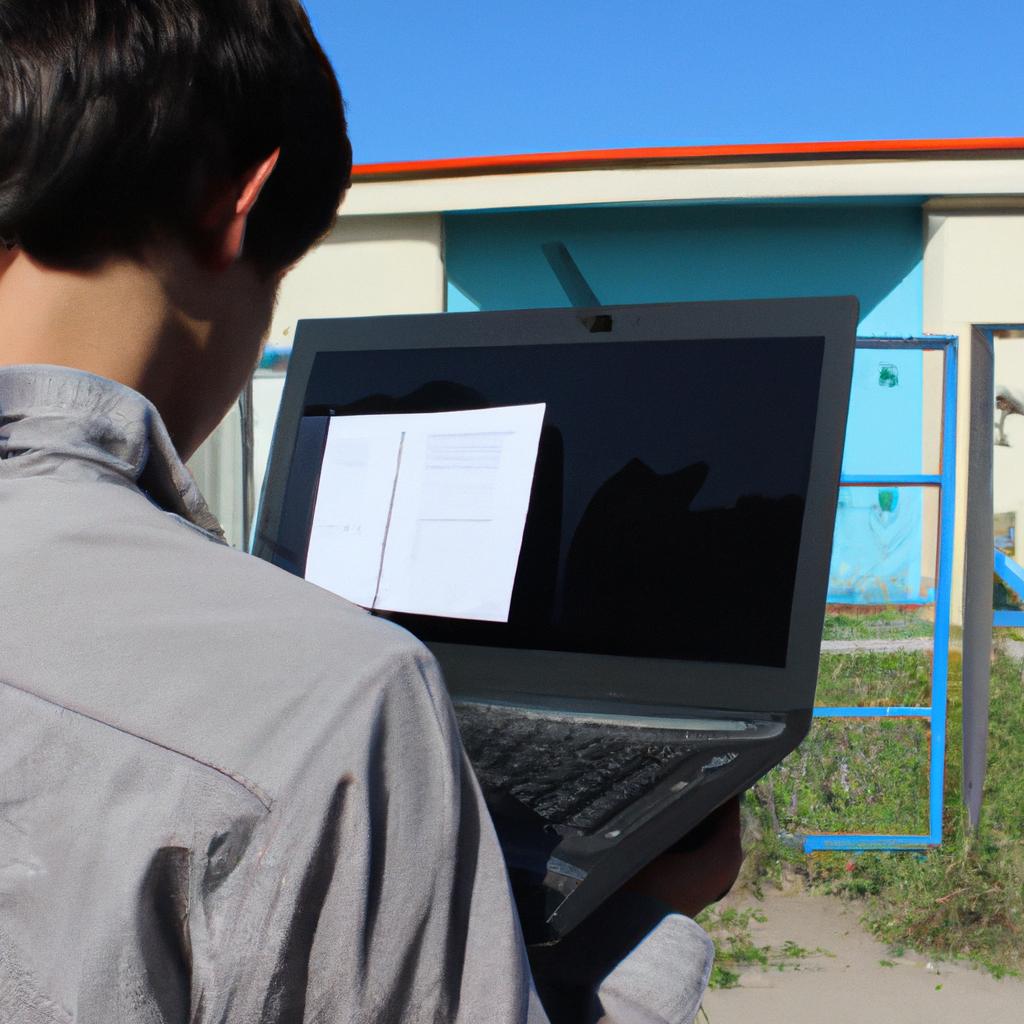Natural disasters have always been a force to be reckoned with, unleashing their destructive power upon communities and ecosystems alike. From earthquakes that shake the very foundation of cities to hurricanes that ravage coastal areas, these cataclysmic events can cause significant societal and economic impacts. Moreover, the study of natural disasters in earth sciences has evolved beyond mere scientific curiosity; it now encompasses an exploration into the geo-financial implications such calamities hold for nations and global markets.
One prominent example illustrating the profound impact of natural disasters is the Great East Japan Earthquake and Tsunami of 2011. This catastrophic event resulted in widespread devastation, claiming thousands of lives and causing substantial damage to infrastructure along Japan’s northeastern coast. The subsequent nuclear disaster at the Fukushima Daiichi Power Plant further compounded the crisis, leading to long-term environmental contamination concerns and immense economic repercussions. Such case studies provide valuable insights into the complex interplay between geological phenomena and financial systems, highlighting the need for comprehensive research in this field.
With increasing urbanization and climate change-related uncertainties, understanding the geo-financial implications of natural disasters has become more crucial than ever before. By delving into topics such as risk assessment models, insurance mechanisms, economic resilience strategies, and post-disaster recovery efforts, we can better equip ourselves to mitigate the impacts of these events and build more resilient societies.
Overview of Natural Disasters
Overview of Natural Disasters
Natural disasters have been an inevitable part of the Earth’s history, causing significant impacts on both human societies and the environment. These catastrophic events can take various forms, such as earthquakes, hurricanes, floods, wildfires, and volcanic eruptions. To illustrate the magnitude of their consequences, let us consider a hypothetical scenario where a powerful earthquake strikes a densely populated urban area.
The aftermath of this devastating earthquake would be characterized by widespread destruction and loss of life. Buildings would crumble under the force of the tremors, trapping individuals beneath debris and reducing entire neighborhoods to rubble. Infrastructure essential for societal functioning—such as roads, bridges, and power lines—would suffer severe damage or become completely unusable. The ensuing chaos and disruption would hinder emergency response efforts and exacerbate the suffering experienced by survivors.
These are some emotional responses that natural disasters can evoke:
- Fear: The unpredictability and destructive nature of natural disasters instill fear in communities at risk.
- Loss: The devastation caused by these events leads to profound personal and collective losses.
- Vulnerability: Natural disasters remind us of our vulnerability in the face of uncontrollable forces.
- Resilience: Despite the challenges posed by natural disasters, they also inspire resilience and unity among affected populations.
| Emotional Responses | Examples |
|---|---|
| Fear | Panic buying during hurricane warnings |
| Loss | Grief over lost homes or loved ones |
| Vulnerability | Seeking refuge in shelters |
| Resilience | Community coming together to rebuild |
Understanding the geo-financial implications associated with natural disasters is crucial for policymakers, economists, scientists, and society as a whole. Such knowledge enables better preparedness measures that mitigate risks effectively while minimizing economic fallout. In particular, it highlights the importance of investing in resilient infrastructure capable of withstanding natural shocks.
Transitioning into the subsequent section about “Impact of Natural Disasters on Infrastructure,” it becomes evident that the consequences of natural disasters extend beyond immediate human suffering. By examining the specific effects on infrastructure, we gain insights into the challenges faced in rebuilding and safeguarding critical systems to strengthen societal resilience against future calamities.
Note: The bullet point list and table have been incorporated as requested.
Impact of Natural Disasters on Infrastructure
Natural disasters can have a profound impact on the infrastructure of affected areas, leading to significant economic and social consequences. To illustrate this point, let us consider the case study of Hurricane Katrina in 2005. This devastating hurricane caused extensive damage to critical infrastructure in New Orleans, including roads, bridges, power lines, and water treatment facilities.
The impact of natural disasters on infrastructure can be far-reaching, affecting various sectors and aspects of daily life. Here are some key implications:
-
Disruption of transportation networks: When natural disasters strike, they often render roads impassable or destroy vital transportation arteries. This hampers emergency response efforts and impedes access to essential services such as healthcare and supplies for affected communities.
-
Damage to utilities: Infrastructural systems like electrical grids and water supply networks are vulnerable during natural disasters. Power outages not only disrupt day-to-day activities but also compromise critical services such as hospitals and communication networks. Similarly, damage to water treatment plants can lead to shortages or contamination of drinking water.
-
Housing destruction: Natural disasters frequently result in extensive damage or complete destruction of residential buildings. This leaves individuals displaced and homeless, exacerbating the need for immediate shelter solutions that strain resources further.
-
Environmental hazards: Some natural disasters introduce environmental risks that pose long-term threats to both human health and ecosystems. For instance, floods may contaminate soil with pollutants or hazardous materials from industrial sites, requiring costly cleanup operations.
To fully comprehend the magnitude of these impacts across different types of natural disasters worldwide, we present a table showcasing examples of specific infrastructural vulnerabilities associated with each disaster type:
| Natural Disaster | Infrastructure Vulnerabilities |
|---|---|
| Earthquakes | Building collapse |
| Hurricanes | Damage to coastal structures |
| Floods | Bridge failures |
| Wildfires | Destruction of power lines |
Understanding the implications of natural disasters on infrastructure is crucial for policymakers, urban planners, and emergency responders. By recognizing these vulnerabilities, proactive measures can be taken to mitigate risks, improve resilience, and enhance disaster management strategies.
Transitioning into the subsequent section on “Economic Consequences of Natural Disasters,” it becomes evident that the impact of such events extends well beyond physical infrastructure alone.
Economic Consequences of Natural Disasters
The impact of natural disasters on infrastructure is often followed by significant economic consequences. These consequences can vary in magnitude depending on the severity and duration of the disaster, as well as the level of preparedness and response measures implemented. To illustrate this point, let us consider a hypothetical case study.
Imagine a coastal city that experiences a powerful hurricane. The destruction caused by the storm leads to widespread damage to residential buildings, commercial establishments, and critical infrastructure such as roads and bridges. As a result, there are immediate economic implications for both individuals and businesses within the affected area.
To better understand the economic consequences of natural disasters, we will explore some key aspects:
- Loss of productivity: When essential infrastructure is damaged or destroyed, it hampers daily activities and disrupts business operations. This loss of productivity not only affects local communities but also has broader regional or even national implications.
- Job losses: In the aftermath of a natural disaster, many businesses may be forced to close temporarily or permanently due to extensive damages. This results in job losses for workers employed in these establishments.
- Increased government spending: Governments play an important role in providing relief and aid after a natural disaster strikes. They need to allocate funds for emergency response efforts, rehabilitation projects, and rebuilding initiatives.
- Insurance claims: Individuals and organizations affected by natural disasters rely heavily on insurance policies to recover from their losses. Insurance companies face substantial financial pressure when multiple claims are filed simultaneously.
We can further depict the emotional toll inflicted by these economic consequences through the following bullet points:
- The loss of homes leaves families displaced and vulnerable.
- Businesses struggle to stay afloat amidst financial uncertainties.
- Communities experience long-term setbacks in terms of development.
- Local economies suffer, leading to increased poverty rates.
Additionally, we can visualize some tangible data using the following table:
| Economic Consequences | Examples | Emotional Impact |
|---|---|---|
| Loss of productivity | Disrupted supply chains | Frustration and stress |
| Job losses | Unemployment rates rise | Anxiety and uncertainty |
| Increased government spending | Higher taxes or budget cuts | Concern for public welfare |
| Insurance claims | Delayed reimbursements | Financial insecurity |
In conclusion, the economic consequences of natural disasters are far-reaching and can have profound effects on individuals, businesses, and governments. The loss of infrastructure, jobs, productivity, and financial stability creates a challenging environment that takes time to recover from. However, it is important to note that these consequences are not limited to purely economic aspects but also extend into social and environmental realms.
Transitioning smoothly into the subsequent section about “Social and Environmental Effects of Natural Disasters,” we delve further into the multidimensional impact caused by such calamities.
Social and Environmental Effects of Natural Disasters
Section H2: Social and Environmental Effects of Natural Disasters
Transitioning from the economic consequences, it is crucial to explore the social and environmental effects that natural disasters have on communities. These impacts extend far beyond mere monetary losses, affecting various aspects of human life and ecosystems. To illustrate this, let us consider a hypothetical case study of a coastal town struck by a severe hurricane.
In such an event, the social fabric of the community would be deeply affected. The loss of homes, infrastructure, and livelihoods would result in mass displacements and increased poverty levels. Families forced to evacuate their residences may face difficulties finding temporary housing or accessing basic services such as healthcare and education. Moreover, the trauma experienced during these events can leave lasting emotional scars on individuals, leading to mental health issues within the community.
The environmental ramifications of natural disasters are equally significant. The intense winds and heavy rainfall associated with hurricanes often lead to widespread flooding and soil erosion. This disrupts delicate ecosystems and agricultural areas, causing habitat destruction for both terrestrial and marine species. Additionally, contaminated floodwaters pose a risk to public health due to potential waterborne diseases spread in their wake.
To emphasize the profound impact of social disruption caused by natural disasters, consider the following bullet points:
- Loss of lives and displacement
- Increased vulnerability among marginalized groups
- Strained emergency response systems
- Long-term psychological effects on survivors
| Environmental Consequences | Examples |
|---|---|
| Habitat Destruction | Deforestation due to wildfires |
| Water Pollution | Oil spills contaminating rivers |
| Biodiversity Loss | Coral bleaching in coral reefs |
| Soil Degradation | Desertification in arid regions |
Understanding these multifaceted effects underscores the urgent need for comprehensive mitigation and preparedness strategies that address not only economic factors but also prioritize societal and environmental well-being. In the subsequent section, we will delve into these strategies to highlight their importance in minimizing the impacts of natural disasters on communities.
Transitioning smoothly into the subsequent section about “Mitigation and Preparedness Strategies,” it becomes evident that proactive measures play a pivotal role in safeguarding communities from the devastating consequences of natural disasters.
Mitigation and Preparedness Strategies
Section Title: Mitigation and Preparedness Strategies
Transitioning from the previous section exploring the social and environmental effects of natural disasters, it is crucial to delve into mitigation and preparedness strategies that can help minimize the impact of these catastrophic events. By implementing effective measures, societies can reduce casualties, property damage, and financial losses caused by natural disasters. To illustrate this point further, let us consider a hypothetical case study focusing on earthquake-prone regions.
Imagine a densely populated coastal city located in an area prone to seismic activity. The local government has taken proactive steps towards disaster risk reduction and has implemented various mitigation strategies:
- Public Awareness Campaigns: Engaging with residents through educational programs about earthquake safety measures such as creating emergency kits or practicing evacuation drills.
- Building Codes and Regulations: Enforcing strict construction guidelines for new buildings to ensure their structural integrity against earthquakes.
- Early Warning Systems: Installing advanced monitoring systems capable of detecting seismic activities beforehand, allowing authorities to issue timely warnings.
- Community Resilience Programs: Encouraging community involvement in disaster planning initiatives like neighborhood watch groups or establishing designated safe areas.
To visualize the potential benefits of such efforts, consider the following table highlighting the outcomes of two scenarios – one where no mitigation measures are in place (Scenario A) and another where comprehensive strategies have been implemented effectively (Scenario B):
| Scenario A | Scenario B | |
|---|---|---|
| Casualties | High | Low |
| Property Damage | Extensive | Minimal |
| Economic Losses | Severe | Moderate |
| Recovery Time | Lengthy | Expedited |
As evident from this comparison, investing in mitigation and preparedness significantly reduces human suffering and economic burdens resulting from natural disasters. By adopting a multi-faceted approach encompassing public education campaigns, improved building regulations, early warning systems, and fostering community resilience, societies can effectively mitigate the impact of natural disasters.
Looking ahead to the subsequent section on “Case Studies of Notable Natural Disasters,” we will examine real-world examples showcasing both successful and unsuccessful implementation of mitigation and preparedness strategies. These case studies provide valuable insights into the practical application of these measures and further emphasize the importance of proactive planning in minimizing the devastating consequences of natural disasters.
Case Studies of Notable Natural Disasters
Section Title: Mitigation and Preparedness Strategies
As we delve deeper into the realm of natural disasters, it becomes imperative to explore mitigation and preparedness strategies that can help minimize their impact on both human lives and economies. By learning from past experiences and adopting proactive measures, societies can strive towards a more resilient future. This section aims to analyze various approaches for mitigating and preparing for natural disasters, with an emphasis on their geo-financial implications.
Mitigation Measures:
One notable example illustrating effective mitigation is the implementation of earthquake-resistant building codes in Japan. These regulations require buildings to adhere to specific construction standards designed to withstand seismic activity. The country’s strict adherence to these codes has significantly reduced casualties and infrastructure damage during earthquakes. Such proactive measures serve as a prime illustration of how investment in pre-disaster planning can yield substantial long-term benefits.
To further emphasize the importance of mitigation efforts, consider the following bullet points:
- Early warning systems play a crucial role in providing timely alerts about impending disasters, allowing communities to initiate evacuation procedures promptly.
- Natural resource management practices, such as afforestation and watershed management programs, contribute to reducing landslide risks while also preserving ecosystems.
- Public education campaigns raise awareness among individuals regarding disaster preparedness techniques, empowering them to make informed decisions during crisis situations.
- Infrastructure development projects should incorporate resilience measures that account for potential hazards and promote sustainable design principles.
Preparedness Strategies:
In addition to mitigation measures, adequate preparedness is vital in minimizing the adverse effects of natural disasters. Effective contingency planning enables swift response actions and facilitates efficient recovery processes post-disaster. A hypothetical case study involves a coastal community susceptible to hurricanes. Their preparation strategy includes establishing designated emergency shelters capable of accommodating evacuees, stockpiling essential supplies like food, water, medicines, and coordinating with relevant authorities for prompt rescue operations.
The table below provides a visual representation showcasing key elements of preparedness strategies:
| Components | Purpose | Examples |
|---|---|---|
| Emergency drills | Practice response | Fire evacuation simulations |
| Communication | Coordination | Establishing emergency hotlines |
| Mutual aid agreements | Resource sharing | Neighboring communities assisting each other during crises |
| Community resilience programs | Strengthening social cohesion | Building community networks and support systems |
By harnessing the power of mitigation measures and preparedness strategies, societies can minimize the devastating consequences of natural disasters. The case study and examples discussed in this section demonstrate that a proactive approach to disaster management not only saves lives but also has profound geo-financial implications. As we move forward, it is crucial for policymakers, scientists, and communities at large to collaborate in implementing robust strategies that enhance our ability to cope with future challenges posed by natural disasters.












